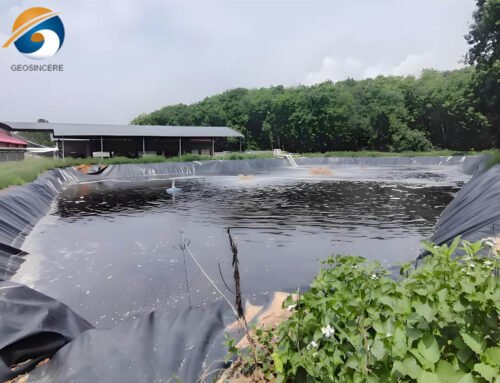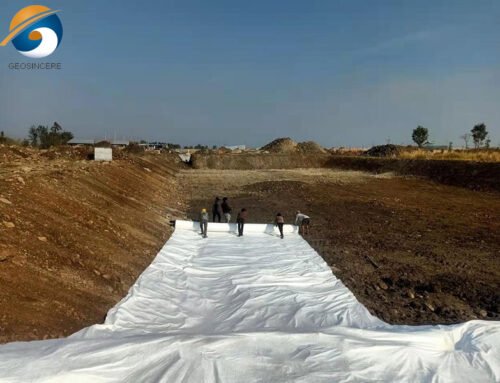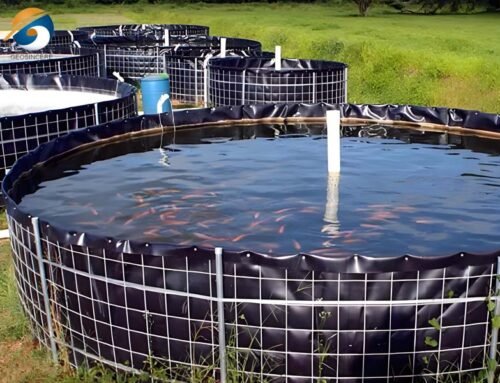In the recent years, with the development of technology and the increase in market demand, the commercialization of geomembrane pond liner services for pond liner has just begun to develop rapidly. Especially fish and shrimp ponds developed a supply of fish and shrimp concentrate feed, fertilize the pond to promote the growth and development of microbial species, and add oxygen and water every quarter. Geomembrane pond liner is one of the major raw materials used in the pond liner. The waterproof layer of the pond uses an anti-seepage geomembrane as a gasket, which plays an important role.
GEOSINCERE HDPE geomembrane gaskets have good durability and are not easily damaged. They not only effectively prevent obstructive air pollutants such as weeds and silt from entering the reservoir, but also reduce microorganisms in the natural environment of the reservoir and reduce the need for fish medicine. In addition, the impermeable geomembrane pond liner can also maintain the anti-corrosion of the reservoir slope, and is also very convenient for maintenance and quick cleanup of sedimentation and waste.In this article we will discuss how to choose geomembrane pond liner.
1. What Are Types Of Geomembrane Pond Liner?
Geomembrane pond liners are essential for creating watertight barriers in various types of ponds, reservoirs, and containment systems. They come in different materials, each with its own set of characteristics and advantages. Here are the main types of geomembrane pond liners:
1.1 High-Density Polyethylene (HDPE)
- Durability: HDPE geomembranes are highly durable and resistant to punctures and tears.
- Chemical Resistance: They offer excellent resistance to chemicals, making them suitable for a wide range of applications.
- Flexibility: These liners are flexible and can be used in both flat and sloped areas.
- UV Stability: Additives like carbon black enhance their UV resistance, extending their lifespan.
1.2 Linear Low-Density Polyethylene (LLDPE)
- Toughness: LLDPE is tougher and more flexible than HDPE, providing better performance in colder climates.
- Environmental Suitability: It’s often used in environmental applications due to its flexibility and resilience.
- Cost-Effective: Generally, it is less expensive compared to HDPE, making it a cost-effective option for large projects.
1.3 Polypropylene (PP)
- Temperature Resistance: PP geomembranes have high melting points, making them suitable for high-temperature environments.
- Chemical Resistance: They offer good resistance to many chemicals but may not be as effective as HDPE or LLDPE in all conditions.
- Lightweight: PP is lightweight and easy to handle during installation.
1.4 Polyvinyl Chloride (PVC)
- Strength: PVC geomembranes are known for their strength and durability.
- Flexibility: They are flexible enough to be used on slopes but stiffer than HDPE and LLDPE.
- Chemical Resistance: PVC provides good chemical resistance but may not be as effective in extreme conditions as HDPE.
1.5 Ethylene Propylene Dichloride (EPDM)
- Elasticity: EPDM geomembranes are highly elastic and can stretch without breaking.
- Durability: They are very durable and resistant to environmental stresses.
- Wide Temperature Range: Suitable for a wide range of temperatures, making them versatile for various applications.


2. What Applications Are Geomembranes Pond Liner Suitable For?
Geomembranes pond liners are versatile materials that find applications in a wide range of scenarios. Here are some of the primary applications for geomembranes as pond liners:
2.1 Agricultural Reservoirs
- Irrigation Storage: They are used to create reservoirs for irrigation water, ensuring a consistent supply for crops and livestock.
- Fish Farming: Suitable for creating fish ponds where water quality and containment are critical.
2.2 Municipal Water Reservoirs
- Drinking Water Storage: Used to line reservoirs that store drinking water to prevent contamination and ensure water quality.
- Wastewater Treatment: Help in constructing lagoons or ponds for wastewater treatment, reducing environmental impact.
2.3 Construction and Infrastructure Projects
- Construction Dewatering: Used in projects requiring dewatering of construction sites to keep them dry.
- Retaining Walls: Employed behind retaining walls to prevent water seepage and soil erosion.
2.4 Environmental Applications
- Landfill Containment: Line landfills to prevent leachate from contaminating the groundwater.
- Hazardous Waste Management: Used in containment systems for hazardous waste to prevent leakage and protect the environment.
2.5 Aquaculture
- Fish Ponds: Create durable and flexible ponds for raising fish, ensuring water quality control and easy maintenance.
- Crab and Shrimp Farming: Provide suitable environments for crustacean farming by maintaining optimal water conditions.
2.6 Residential and Commercial Landscaping
- Garden Ponds: Used in residential landscaping to create beautiful and functional garden ponds.
- Water Features: Perfect for commercial properties like hotels or parks that feature decorative water bodies.
2.7 Ecosystem Restoration
- Wetland Restoration: Help in recreating wetlands by providing waterproof barriers that can hold water and support plant life.
- Marsh Creation: Assist in the creation of marshlands, which are crucial for biodiversity and natural filtration.
2.8 Flood Control
- Flood Barriers: Used to construct temporary flood barriers to manage and divert floodwaters during high rainfall events.
- Stormwater Management: Help in managing stormwater runoff, reducing the risk of flooding and erosion.
2.9 Industrial Applications
- Chemical Storage: Line ponds and lagoons used for storing industrial chemicals, preventing leakage and contamination.
- Cooling Water Ponds: Used in industrial settings to create cooling water reservoirs for machinery and processes.
2.10 Mining Operations
- Tailings Management: Utilized in mine tailings management facilities to contain waste materials and prevent environmental pollution.
- Acid Mine Drainage (AMD) Treatment: Help in constructing ponds for treating acidic water generated from mining operations.
3. How To Choose Right Geomembrane Pond Liner?
Choosing the right geomembrane pond liner involves considering several factors to ensure it meets the specific needs of your project. Here’s a comprehensive guide to help you make an informed decision:
3.1 Determine the Purpose
- Application: Identify the primary use of the pond liner (e.g., agricultural reservoir, fish farming, wastewater treatment).
- Environmental Conditions: Consider the environmental conditions such as temperature extremes, chemical exposure, and potential for punctures or tears.
3.2 Material Selection
- High-Density Polyethylene (HDPE): Durable, resistant to chemicals and UV radiation. Ideal for most applications due to its strength and longevity.
- Linear Low-Density Polyethylene (LLDPE): More flexible than HDPE, suitable for colder climates and areas requiring flexibility.
- Polypropylene (PP): High melting point, good for high-temperature environments.
- Polyvinyl Chloride (PVC): Strong but less flexible, good for flat surfaces.
- Chlorinated Polyethylene (CPE): Good flexibility and weather resistance, often used in roofing and liners.
- Ethylene Propylene Dichloride (EPDM): High elasticity and durability, suitable for a wide range of temperatures.
- Butyl Rubber: Extremely flexible, excellent for irregular shapes and specialized uses.
3.3 Thickness
- Project Requirements: Thicker liners provide more durability and are better suited for projects with higher stress levels or potential hazards (e.g., sharp objects).
- Standard Thicknesses: Common thicknesses range from 0.5 mm to 3 mm, depending on the application and environmental conditions.


3.4 Dimensions
- Size and Shape: Measure the dimensions of the pond area accurately to ensure you have enough material to cover the entire surface with some overlap.
- Joining Methods: Decide on the joining methods (e.g., heat welding, adhesive bonding) based on the size of the liner and the ease of installation.
3.5 Durability and Lifespan
- Expected Lifespan: Consider how long the liner needs to last. HDPE and LLDPE typically offer longer lifespans compared to other materials.
- Warranty: Look for manufacturers that offer warranties on their products as an indicator of quality and durability.
3.6 Chemical Resistance
- Exposure to Chemicals: Ensure the liner material is resistant to any chemicals it will be exposed to, particularly important for industrial or wastewater applications.
3.7 Flexibility and Elasticity
- Geometric Constraints: For ponds with slopes or irregular shapes, choose a material with high flexibility and elasticity (e.g., LLDPE, EPDM).
3.8 Installation Ease
- Ease of Handling: Consider the weight and flexibility of the material. Lighter and more flexible materials are easier to handle and install.
- Seaming Requirements: Some materials are easier to join than others. HDPE is commonly welded, while PVC may require adhesive bonding.
3.9 Cost
- Budget: Balance the initial cost with the long-term benefits. While some materials might be more expensive upfront, they could offer greater savings over time due to their durability and lower maintenance requirements.
3.10 Environmental Impact
- Sustainability: Consider eco-friendly options and disposal methods for the liner at the end of its lifecycle.
- Regulations: Ensure compliance with local environmental regulations and standards.
3.11 Supplier Reputation
- Manufacturer Quality: Choose a reputable manufacturer known for producing high-quality geomembranes.
- Customer Support: Check if the supplier offers technical support and after-sales service.
4. Conclusion
Choosing the right geomembrane pond liner involves a combination of understanding your project needs, considering environmental conditions, selecting the right material, and ensuring professional installation. HDPE is often the go-to for large, industrial projects,Users can choose the appropriate breeding geomembrane based on their actual situation, usage environment, and service life. It is recommended that customers look for reliable manufacturers and avoid buying shoddy products.
GEOSINCERE has been dedicated to manufacturing and supplying geomembrane and geosynthetics solutions globally since 2007. Our innovative, high-quality products include geotextiles, geomembrane, geogrid, geocells, geosynthetics clay liners, and drainage boards. Our customers span over 1,000 countries, including the USA, Australia, France, and many more. GEOSINCERE offers not only high-quality geomembrane but also professional installation services. For any inquiries about geomembrane, feel free to contact us.





